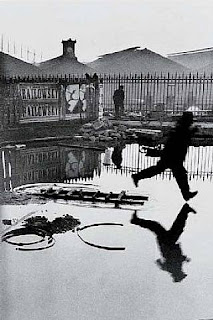Art Photography
 |
| 1. Lady Gaga and Kayne West - David LaChapelle |
 |
| 2. Cameron Diaz - David LaChapelle |
vs.
Press Photography
 |
| USA. 1947. Fire in Hoboken, facing Manhattan. Henri Cartier-Bresson |
 |
| FRANCE. 1932. Paris. Place de l'Europe. Gare Saint Lazare. Henri Cartier-Bresson |
I think the two press photographs and the two art photographs I chose are completely different from each other. In the two art photographs by David LaChapelle, you can tell that the photographer planned the shoot and that he is highly visible. In the two press photographs by Henri Cartier-Bresson, you can tell that these photographs weren’t planned and the photographer is invisible. In the art photos, especially the one with Lady Gaga and Kayne West, you can guess that this photo was definitely edited after the picture was taken (the volcano in the background and Kayne West’s eyes), whereas the press photographs look unedited.
Charles Caffin said “There are two distinct roads in photography – the utilitarian and the aesthetic: the goal of one being a record of facts, and the other an expression of beauty” (Danilovic). I think art photography is an expression of beauty, and it’s supposed to be enjoyed for what it is. Therefore, I think it’s ethical and acceptable to alter art photographs. Art photographers may have an image in their mind that they want to capture, and since their photograph will be used as an expression of beauty, I think it’s okay for the photographer to edit the photo after the picture is taken to make it into the image they imagined.
As Charles Caffin says in the quote above, I think the goal of press photography is to record facts. Andre Kertesz and Henri Cartier-Bresson both thought they needed to be invisible when taking photos (Danivolic). I completely agree that a photojournalist should be invisible when taking photos and for that reason I think it is not ethical or acceptable to alter press photographs. By altering press photographs you are removing the truth behind the photo. If the photographer stages the shot, or changes parts of the photo (such as lighting) to pull the eye to a certain part of the picture, the photo is no longer showing the truth because it has been manipulated to draw your eye to what the photographer wanted you to see instead of seeing exactly what the situation was.
References:
Danivolic, Sandra "Shooting the Truth" Week 4
Danivolic, Sandra "Shooting the Truth" Week 10
Pictures:
1. LaChapelle Studio - Portraits - Lady Gaga. (n.d.). LaChapelle Studio. Retrieved March 19, 2011, from http://www.lachapellestudio.com/portraits/lady-gaga/?ci=112
2. LaChapelle Studio - Portraits - Cameron Diaz. (n.d.).LaChapelle Studio. Retrieved March 19, 2011, from http://www.lachapellestudio.com/celebrities/cameron-diaz/?ci=27
3 and 4. Henri Cartier - Bresson. (n.d.).Magnum Photos. Retrieved March 19, 2011, from http://www.magnumphotos.com/Archive/C.aspx?VP=XSpecific_MAG.PhotographerDetail_VPage&l1=0&pid=2K7O3R14T1LX&nm=Henri%20Cartier%20-%20Bresson
No comments:
Post a Comment